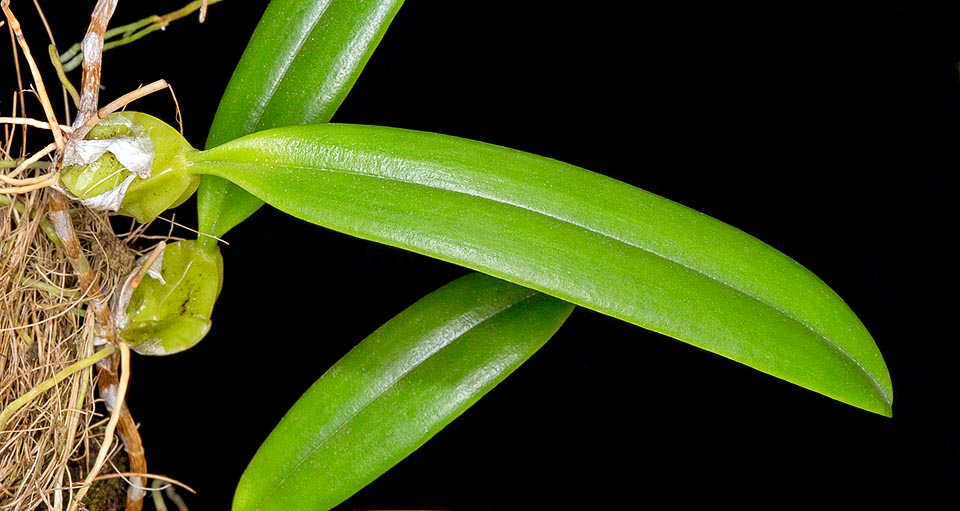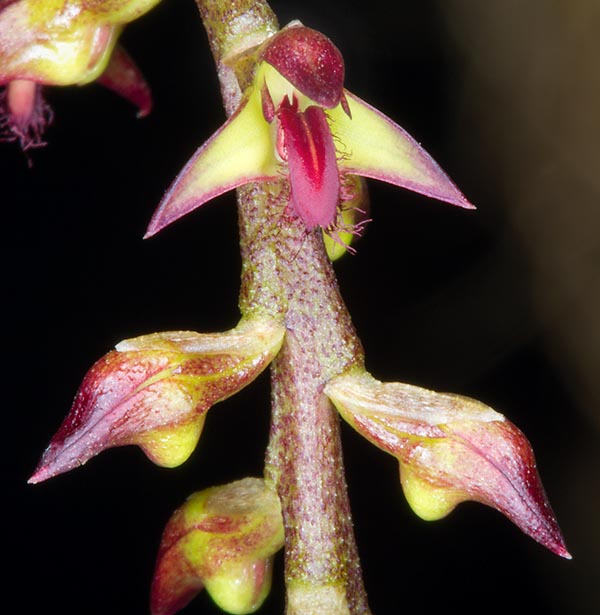Family : Orchidaceae

Text © Pietro Puccio

English translation by Mario Beltramini

The Bulbophyllum incurvum is an epiphytic miniature orchid native to Madagascar, Mauritius, Réunion and Rodrigues forests, with about 1,5 cm long ovoid pseudobulbs, spaced on a creeping rhizome, rooting at the nodes. They have 4-5 prominent ribs and only one coriaceous glossy leave, intense green, even 8 cm long © Giuseppe Mazza
The name of the genus is the combination og the Greek substantives “βολβός” (bolbos) = bulb and “φύλλον” (phyllon) = leaf, with reference to the leaves growing at the apex of the pseudobulbs; the specific name is the Latin adjective “incurvus, a, um” = curved, bent, with reference to the drooping inflorescence.

As the specific name suggests, the Bulbophyllum incurvum inflorescence is a drooping spike with several small flowers of 5-8 mm of diameter of variable colour, wholly yellow, to red, to bicolour. Pointed sepals, much smaller rounded petals, and mobile oblong labellum with sleek ciliate margins © Giuseppe Mazza
It reproduces by seed, in vitro, and by division, withe each section provided of at least 3-4 pseudobulbs, at the vegetative restart.
Miniature orchid rare in cultivation, requires semi-shaded position, medium-high temperatures, 22-30 °C, in summer, slightly cooler in winter, with lowest night ones not under the 15 °C, high humidity, 70-85%, and constant ventilation. The waterings must be regular and abundant in summer, more spaced in winter, but without allowing the substratum to dry up completely, utilizing rain water, demineralized or by reverse osmosis. It is usually mounted on trunks, bark or rafts of roots of arborescent ferns with some sphagnum at the base of the plant, less frequently in pots or baskets rather wide in order to allow the pseudobulbs to freely expand, utilizing a compost formed by bark fragments and charcoal with possible addition of sphagnum to maintain the humidity if the cultivation ambient is rather dry. The repottings are to be done when the compost has deteriorated at the vegetative restart, marked by the emission of the new roots.
The species is reported in the appendix II of CITES (species whose trade is internationally ruled).
Synonyms: Phyllorchis incurva (Thouars) Kuntze (1891); Phyllorkis incurva (Thouars) Kuntze (1891).
→ For general notions about ORCHIDACEAE please click here.
